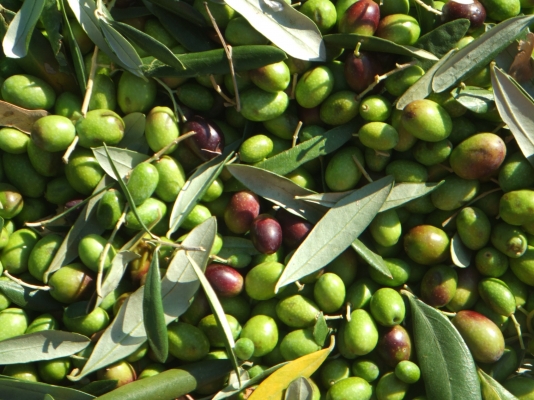Frantoio: Late maturing variety, medium sized fruit, long shape having some spots, round shape and lower part is medium deep, violet color when turns at maturity, round, green flesh, gives average yield of 15-20kg and contains 26% oil content.
Coratina: Fruit having medium to small weight and shape which will depend upon more or less crop growth, long shape, lower part is less deep and is irregular, gives an average yield of 10-16kg per plant, contains 22-24% oil content, plant having medium growth but spreading.
Leccino: Late maturing variety, fruit has medium shape and weight, egg shaped fruit, violet color at maturity, top of fruit is cone shaped but lower part is deep and is irregular, gives average yield of 10-15kg per plant.
Ascoterana: Fruit has medium size and weight, long, violet color at maturity, green color flesh, top part is round in shape, lower part is less deep and upto some extent irregular in shape, gives yield of 20-25kg per tree, plant is medium growing and is of spreading nature.
Ascolano: Fruit is of big size and has more weight, long shape, violet, top part is round in shape and lower part is deep and irregular, gives yield of 5-10kg per tree, contains 10-17 oil content, spreading plant, early to medium maturing variety.
Pendolino: Plants branches are bent downwards, plant size and stem is medium thick, medium growth of the plant, fruit has medium size, long, peel having few spots which is violet in color, deep green, top part of fruit is round in shape and lower part is deep and irregular, short peduncle, kernel has medium size and weight, long, kernel is round in shape having upper part pointed, kernel has rough orange color surface, late maturing variety, contains 20% oil content and 65% water content.
Other state varieties:
It has two types
Oil type: Ascolanaterena, Aglandeau, Carolea, Canino, Frontoio, Pendolino.
Pickle type: Ascolano, Coratina, Cornicobra, Grosseune, Mission, Picholine.
Imported from Israel: Barnea, Arbequina, Cortina, Picholine, Picual, Coraniki and Frontoio
Ascolanaterena: Trees are compact type with black fruits. It is resistant to severe cold.
Canino: Trees are spreading type and fruits are small.
Carolea: Trees are short and compact; fruits are large, oval shape and bright black color.
Coratina: Suitable for pickling. Fruits are large and oval shape. The variety is resistant to cold and drought.







